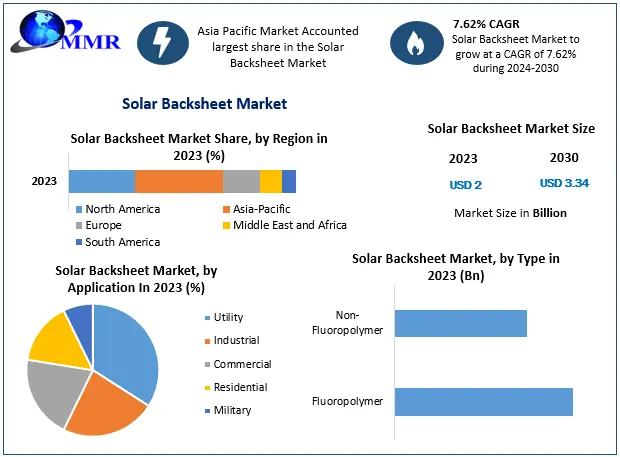Introduction
As the world moves towards clean energy, solar power has become a key solution for reducing environmental impact and energy costs. Behind every efficient solar panel lies a crucial component often overlooked—the solar backsheet. This protective layer plays an essential role in ensuring the performance, durability, and safety of solar modules.
The solar backsheet market has seen notable growth over the years, driven by innovation, rising installations of photovoltaic systems, and evolving energy demands. This article explores current developments, market trends, and the expected outlook of the solar backsheet market leading up to 2030.
What Is a Solar Backsheet?
A solar backsheet is the outermost layer on the back of a solar panel. It protects the internal components from environmental conditions such as moisture, UV radiation, dirt, and mechanical stress. A high-quality backsheet is vital to prevent electrical failure and to maintain long-term panel efficiency.
Typically made from polymer-based materials, backsheets are designed for durability, insulation, and weather resistance. Their performance directly affects the overall life and reliability of a solar module.
Market Developments and Trends
In recent years, several trends have shaped the solar backsheet industry:
1. Rise in Renewable Energy Projects
Governments and corporations around the world are heavily investing in solar energy. As utility-scale solar installations increase, the demand for advanced and durable backsheets continues to rise.
2. Material Innovations
Manufacturers are focusing on new materials like fluoropolymer-based and non-fluoropolymer backsheets. These newer materials aim to reduce costs while offering strong protection. Dual-layer and triple-layer constructions are also becoming common to increase performance.
3. Growing Preference for Transparent Backsheets
With bifacial solar panels gaining popularity, transparent backsheets are becoming more widespread. These allow light to reach both sides of the panel, increasing energy output and overall efficiency.
4. Shift Towards Recyclability and Sustainability
The solar industry is working toward reducing its environmental footprint. Recyclable backsheet materials are being developed to align with eco-friendly practices and lifecycle sustainability.
5. Stringent Quality Standards
Due to earlier failures caused by poor-quality backsheets, industry regulations are becoming more strict. Manufacturers are expected to meet international safety and durability standards.
Market Growth Drivers
Several key factors are fueling the growth of the solar backsheet market:
– Increased Solar Panel Installations
With the global focus on reducing carbon emissions, solar power is being adopted faster than ever. Both rooftop and ground-mounted solar installations are contributing to the growing need for high-performance backsheets.
– Technological Advancements
Improved manufacturing processes and material development have enabled the production of more efficient and long-lasting backsheets. This, in turn, has increased their reliability and demand.
– Government Support and Subsidies
Incentives and subsidies for renewable energy projects have made solar installations more affordable. As solar demand rises, so does the need for dependable backsheet solutions.
– Lowering Cost of Solar Panels
The decreasing cost of solar panels has led to wider adoption among residential, commercial, and industrial users. This trend fuels consistent demand in the backsheet market.
– Focus on Energy Security and Diversification
Countries want to reduce their dependence on fossil fuels. Solar energy offers a stable and clean source, boosting the growth of associated industries such as solar backsheet manufacturing.
Market Challenges
Despite the positive outlook, the market faces some challenges:
– Price Sensitivity
Manufacturers often face pressure to keep prices low. This can sometimes result in lower-quality materials being used, affecting long-term panel performance.
– Supply Chain Disruptions
Raw material shortages and global supply chain disruptions have occasionally slowed production and delivery timelines, especially during global crises like the COVID-19 pandemic.
– Technical Failures and Product Recalls
Past issues related to delamination, discoloration, and cracking of backsheets have raised concerns about product reliability. This highlights the need for better quality control.
– Competition from Glass-Glass Modules
Glass-glass solar modules are emerging as an alternative to traditional backsheet designs. These modules use glass on both sides, which may reduce the need for polymer-based backsheets in some applications.
Regional Insights
The solar backsheet market varies by region due to different policies, infrastructure, and adoption rates.
– Asia-Pacific
This region dominates the market, with countries like China, India, and Japan leading solar energy adoption. Large-scale solar farms and industrial installations drive demand for reliable backsheets.
– North America
The United States is investing heavily in clean energy infrastructure. Rooftop solar and commercial solar projects are growing steadily, boosting the local backsheet market.
– Europe
Sustainability goals and high environmental standards make Europe a key player in renewable energy. European countries also prefer recyclable and environmentally friendly backsheet materials.
– Middle East and Africa
These regions are emerging players in solar energy, particularly in areas with abundant sunlight. Governments are exploring solar energy as part of their national development goals.
Future Outlook: What to Expect by 2030
As we look ahead, the solar backsheet market is expected to continue its growth. Here’s what we might see by 2030:
- Smarter Materials: Backsheets with self-healing, reflective, or AI-monitored properties may enter the market to enhance performance.
- Recyclable Components: More manufacturers will likely adopt sustainable materials to meet global recycling regulations.
- Bifacial Panel Growth: Transparent backsheets will be in greater demand to support dual-sided solar modules.
- Global Expansion: Markets in Africa, South America, and Southeast Asia will play a bigger role in driving solar installations and backsheet consumption.
- Lower Manufacturing Costs: Innovations in production techniques will bring down prices without compromising quality.
Conclusion
The solar backsheet market is a key part of the solar power industry. As demand for clean energy continues to rise, so does the need for reliable and durable solar panels—and the backsheets that protect them. With constant innovation, material advancements, and growing global adoption, the market is on track for impressive growth by 2030.
For solar panel manufacturers and installers, choosing high-quality backsheets is more than just a technical decision—it’s a long-term investment in performance and sustainability. As the world leans further into renewable energy, the role of the solar backsheet will become more important than ever.












